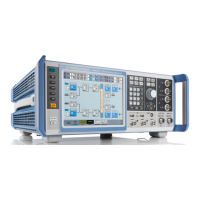Trying Out the Instrument
R&S
®
SMW200A
47Getting Started 1412.9220.02 ─ 21
6 Trying Out the Instrument
This chapter introduces the most important functions and settings of the
R&S SMW step by step. The complete description of the functionality and its
usage is given in the R&S SMW user manual. Basic instrument operation is
described in Chapter 8, "Instrument Control", on page 97.
See also:
●
"To start a tutorial in an interactive step-by-step mode" on page 110
Prerequisites
●
The instrument is set up, connected to the power supply, and started up as
described in Chapter 4, "Preparing for Use", on page 15.
●
Throughout this description, the term base unit describes a R&S SMW equip-
ped with the options R&S SMW-B10, R&S SMW-B13, and R&S SMW-B103.
For the first signal generation tasks, you use the internal baseband and reference
signal, so you do not need any additional signal source. More complex signal
generation tasks, however, require an instrument equipped with additional options
and/or external signals. Each task description lists its prerequisites.
The screenshots in this description show a fully equipped instrument. Con-
sider that, the block diagram displayed on your particular instrument can dif-
fer from the one used in the example.
The instrument is manually operated via the touchscreen. Try out the following:
● Generating an Unmodulated Carrier............................................................... 48
● Generating a Digitally Modulated Signal......................................................... 51
● Triggering the Instrument with an External Signal...........................................53
● Enabling and Configuring a Marker Signal......................................................60
● Routing the Signal through the Instrument and Defining the Output Connec-
tors.................................................................................................................. 61
● Verifying the Generated Signal with the Graphics Display..............................66
● Saving and Recalling Settings........................................................................ 70
● Generating an EUTRA/LTE Signal.................................................................. 73
● Using the System Configuration Capabilities for MIMO Setups......................77

